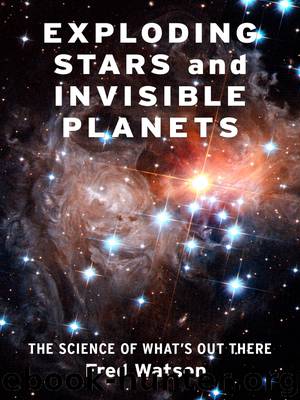Exploding Stars and Invisible Planets by Fred Watson

Author:Fred Watson
Language: eng
Format: epub
Tags: SCI005000, Science/Physics/Astrophysics, SCI004000, Science/Astronomy
Publisher: Columbia University Press
Published: 2019-01-14T00:00:00+00:00
IN 1979, NASA’S PIONEER 11 BECAME THE FIRST SPACECRAFT to study Saturn and its rings during a fleeting encounter with the planet. The trouble with spacecraft undertaking grand tours of the planets, as Pioneer 11 was, is that they can’t hang around. It sped past Saturn at a cool 32 kilometres per second. Among Pioneer’s discoveries were a previously unknown moon (Epimetheus – which it nearly collided with) and a narrow ring on the outer edge of the main ring. That main ring, by the way, is known as the A-ring, and the new one – being the sixth to be identified as a separate entity – became the F-ring. In reality, all the rings of Saturn are made up of finer ‘ringlets’, which appear to merge together when seen from a distance.
Pioneer 11 paved the way for Voyager 1 and Voyager 2, which flew by Saturn in 1980 and 1981 respectively. Spoke-like features in the main ring system and braided strands in the F-ring were among their legacy discoveries, setting the scene for one of the most productive space projects ever – the incomparable Cassini. Launched in 1997, Cassini arrived at Saturn in July 2004, and provided extraordinary images and data on the planet, its rings and its moons for 13 years. You’ll notice it makes several starring appearances in this book. Its demise, in September 2017, was one of the most poignant moments in the history of spaceflight, when the craft was intentionally flown into Saturn’s outer atmosphere to vaporise and become part of the planet it had so generously laid open for humankind. Remarkably, new discoveries have continued to emerge from the copious data it provided, long after it has gone. And they include some surprising Saturnian secrets.
The question of why the planet has such magnificent rings, making it undoubtedly the pearl of the Solar System, has occupied the minds of scientists since Huygens’ time. As has a related conundrum: were the rings formed with Saturn, or are they a more recent addition? While those questions haven’t yet been completely answered, we now have a much better idea of how – and, in particular, when – the rings originated. This emerges from an understanding of their ultimate fate, because it turns out that the rings are not permanent.
Download
This site does not store any files on its server. We only index and link to content provided by other sites. Please contact the content providers to delete copyright contents if any and email us, we'll remove relevant links or contents immediately.
| Aeronautics & Astronautics | Astronomy |
| Astrophysics & Space Science | Comets, Meteors & Asteroids |
| Cosmology | Mars |
| Solar System | Star-Gazing |
| Telescopes | UFOs |
Tools of Titans by Timothy Ferriss(8311)
Turbulence by E. J. Noyes(7983)
Secrets of Antigravity Propulsion: Tesla, UFOs, and Classified Aerospace Technology by Ph.D. Paul A. Laviolette(5338)
Astrophysics for People in a Hurry by Neil DeGrasse Tyson(5153)
Room 212 by Kate Stewart(5077)
Design of Trajectory Optimization Approach for Space Maneuver Vehicle Skip Entry Problems by Runqi Chai & Al Savvaris & Antonios Tsourdos & Senchun Chai(5040)
Pale Blue Dot by Carl Sagan(4961)
The David Icke Guide to the Global Conspiracy (and how to end it) by David Icke(4659)
A Journey Through Divination and Astronomy by Publishing Pottermore(4364)
Goodbye Paradise(3767)
Apollo 8 by Jeffrey Kluger(3673)
COSMOS by Carl Sagan(3593)
The Five People You Meet in Heaven by Mitch Albom(3524)
Losing the Nobel Prize by Brian Keating(3521)
How to Read Water: Clues and Patterns from Puddles to the Sea (Natural Navigation) by Tristan Gooley(3434)
Brief Answers to the Big Questions by Stephen Hawking(3394)
How to Read Nature by Tristan Gooley(3295)
The Order of Time by Carlo Rovelli(3164)
A Brief History of Time by Stephen Hawking(2995)
